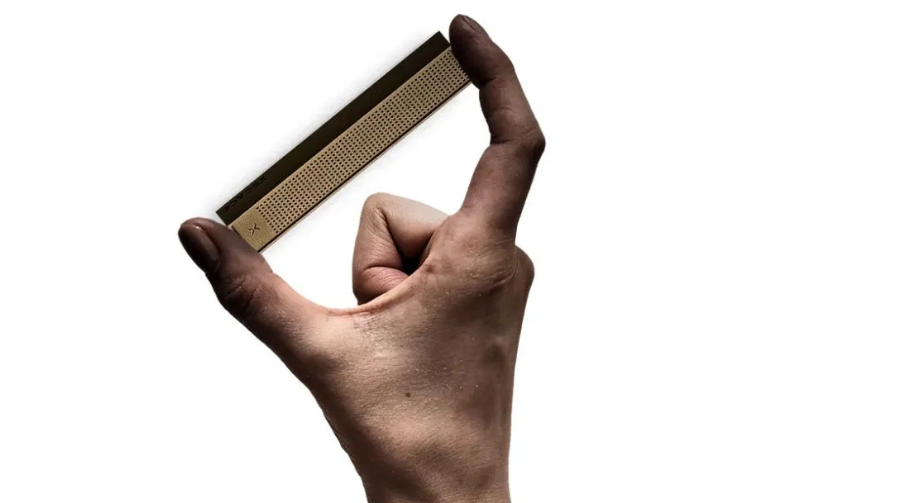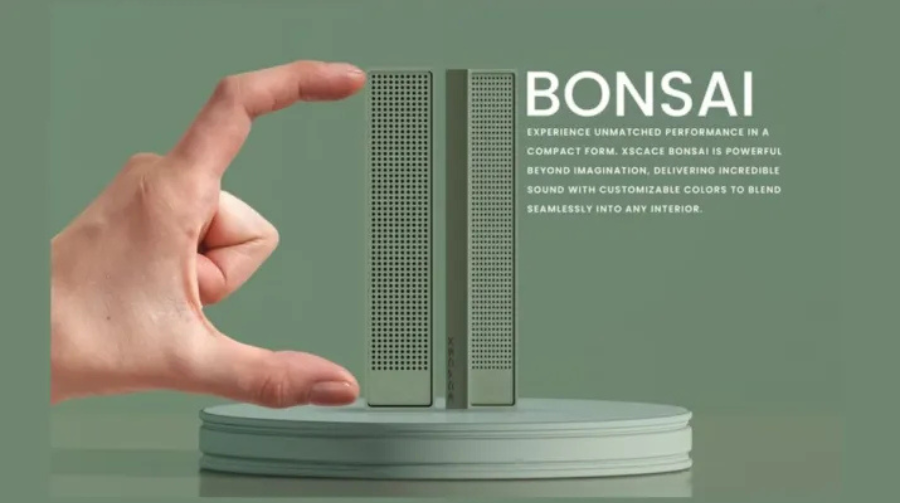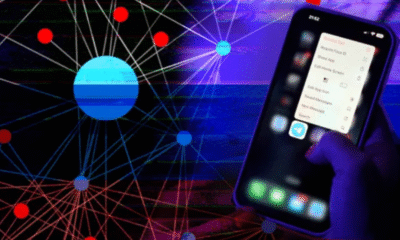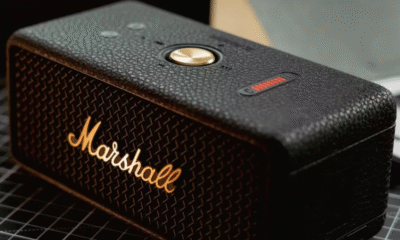Gadgets
XSCACE Bonsai Speakers: Smallest Marvel, Biggest Impact — Your Music, Reimagined

Design That Redefines Minimalism
The first thing you’ll notice about the XSCACE Bonsai Speakers is their strikingly sleek and artistic design. True to their name, these speakers resemble tiny bonsai plants, making them a perfect decor piece for modern homes and workspaces.
- Lightweight and highly portable
- Eco-friendly materials
- Elegant shape that blends into any setting

Big Sound in a Tiny Package
Don’t let their small size fool you. XSCACE Bonsai Speakers deliver surprisingly rich, crisp, and immersive sound quality. Whether you’re listening to lo-fi beats while working, streaming your favorite series, or hosting a small gathering, these speakers rise to the occasion.
- Deep bass and clear treble
- Bluetooth 5.0 connectivity for seamless pairing
- 360-degree audio distribution

Why You Need It in Your Space
Beyond just sound, the XSCACE Bonsai Speakers act as a conversation starter. Their compact size means they can fit virtually anywhere — desks, bookshelves, bedside tables — without cluttering your space.
Perfect for:

- Minimalist home setups
- Tiny apartments or dorm rooms
- Travelers and digital nomads
- Gift ideas for design lovers

Where to Buy and Pricing
The XSCACE Bonsai Speakers are available on the official website and major online retailers like Amazon and Flipkart. Prices start at around ₹4,999, making them an affordable yet premium addition to your audio setup.
Gadgets
📰 Refined Article: Dhanteras Sale 2025 – Xiaomi, Samsung & More Slash 43-inch Smart TV Prices by Half on Amazon

As the festive season peaks, Amazon’s Diwali and Dhanteras sale has brought some of the biggest discounts of the year on electronics — and this time, 43-inch 4K Smart TVs are at the center of attention. Major brands including Xiaomi, Samsung, Toshiba, TCL, and Philips are offering massive price cuts, bringing premium entertainment within reach of most Indian households.
If you’ve been waiting to upgrade your home entertainment setup, this Dhanteras might be the perfect opportunity — with prices starting under ₹17,000 for 4K UHD Smart TVs.
💥 Top 43-Inch Smart TV Deals on Amazon
1. Toshiba 43-inch 4K UHD Smart TV
- Discounted Price: ₹19,999 (MRP ₹39,999)
- Additional Bank Offer: Up to ₹3,000 off → effective price ₹16,999
- Features:
- Google TV OS
- Dolby Digital, HDR10, and HLG support
- Built-in voice assistant
- Why Buy: One of the most affordable 4K UHD TVs in its range with impressive display brightness and colour depth.

2. Xiaomi TV 43-inch FX Pro 4K Smart TV
- Sale Price: ₹23,999 (47% off)
- Additional Offers: ₹3,000 bank discount + ₹1,500 coupon
- Effective Price: Around ₹20,999
- Highlights:
- 4K Ultra HD with vivid picture engine
- Dolby Audio and DTS:X sound
- PatchWall+ and Google TV integration
- Why Buy: Xiaomi’s latest model balances affordability with premium performance, perfect for OTT lovers.
3. Samsung 43-inch Vision AI 4K UHD Smart TV
- Listed Price: ₹33,490 (39% off, down from ₹54,990)
- Extra Bank Offer: ₹3,000 instant discount
- Key Features:
- Vision AI processor for enhanced upscaling
- Smart Hub and built-in Alexa
- Sleek, bezel-less design
- Why Buy: Great for brand-conscious buyers seeking top-tier display quality with AI optimization.

4. Philips 43-inch QLED Smart TV
- Offer Price: ₹21,499 (down from ₹29,999)
- Additional Discount: ₹3,000 on select cards
- Specs:
- QLED panel with Dolby Vision
- HDR10+ support
- Android TV platform
- Why Buy: Delivers premium colour accuracy and contrast at a mid-range price.
🎯 Festive Season Buying Tip
During Dhanteras and Diwali, Amazon and Flipkart also offer no-cost EMI, exchange bonuses, and card-specific cashback offers from leading banks such as HDFC, ICICI, and SBI. Always compare final checkout prices before purchasing to maximise total savings.
Industry analysts say that the 43-inch category remains India’s most sought-after TV size due to its balance between screen size, room fit, and affordability — making this Dhanteras sale one of the best times to upgrade.
🪔 Final Takeaway
With deep discounts, cashback offers, and festive benefits, these Dhanteras Smart TV deals make 4K entertainment more accessible than ever. Whether you prefer Samsung’s AI-led visuals or Xiaomi’s feature-packed affordability, the current price drops are unlikely to return until next year’s sale season.
Gadgets
MiG-21 Farewell: From 1965 War to Balakot, India’s Iconic Fighter Jet Retires After Six Decades of Service

Chandigarh, September 26, 2025
After nearly six decades of glorious service, the Indian Air Force’s (IAF) MiG-21 fighter jet bid farewell to the skies today in a historic retirement ceremony in Chandigarh. The farewell marks the end of an era for the world’s longest-serving fighter jet, which not only defended India during critical wars but also symbolized the country’s growing air power for generations.
The IAF hosted a grand ceremony that included aerial displays, formation flights, and a symbolic water cannon salute as the last MiG-21s touched down for the final time.
Reliving Its Glorious Past in Wars
- 1965 & 1971 Indo-Pak Wars: The MiG-21 first proved its mettle in the 1965 war and went on to dominate the skies during the 1971 Bangladesh Liberation War. One of its most iconic strikes was the bombing of the Dhaka Governor’s House, a mission that crushed the morale of East Pakistan’s leadership.
- Kargil Conflict (1999): MiG-21s carried out critical ground-attack missions in the high-altitude battles of Kargil.
- Balakot Air Strike (2019): A MiG-21 Bison, flown by Wing Commander Abhinandan Varthaman, famously shot down a Pakistani F-16, showcasing that even an ageing jet could hold its own against modern adversaries.

Final Flight and Farewell Ceremony
The farewell was both emotional and symbolic:
- Air Chief Marshal AP Singh took the cockpit to lead the final sortie.
- Squadron Leader Priya Sharma led the historic last operational flight.
- Special formations like the Victory Formation by the IAF’s 23rd Squadron “Panthers” and a Cloud Formation of MiG-21s with Tejas jets highlighted the transition from an old warrior to India’s indigenous future fighter.
- The event concluded with six MiG-21s landing together, shutting down engines for the last time, and receiving a traditional water cannon salute.
Dignitaries including Defence Minister Rajnath Singh, Chief of Defence Staff General Anil Chauhan, chiefs of all three armed services, and former IAF chiefs witnessed the send-off.
The Legacy of the MiG-21 in India
- Induction: Entered IAF service in 1963.
- Numbers: India acquired 874 MiG-21s, making it the backbone of the IAF for decades.
- Upgrades: The final variant, the MiG-21 Bison, was inducted in 2013 with modern avionics and weapons.
- Role: Served as a multirole fighter, excelling in air defense, ground attack, and interception roles.
The MiG-21 not only served as India’s frontline fighter for decades but also trained generations of IAF pilots, many of whom earned their wings on this aircraft.

The Controversial Side: “Flying Coffin” & “Widow Maker”
Despite its success, the MiG-21 was plagued by safety concerns:
- Accidents: Over 400 crashes have been recorded since induction.
- Casualties: Many young IAF pilots lost their lives, giving the jet grim nicknames like “Flying Coffin” and “Widow Maker”.
- Reasons: Outdated design, ageing airframes, engine failures, and maintenance challenges contributed to its poor safety record.
This long-standing criticism was a major factor behind the decision to finally phase it out.
Transition to the Future
The MiG-21 will now pass the baton to more modern fighters like the HAL Tejas, Rafale, and the upcoming AMCA (Advanced Medium Combat Aircraft). The farewell ceremony’s formation flight with MiG-21s and Tejas symbolized this generational shift in India’s aerial defense.

Conclusion
The retirement of the MiG-21 marks the end of an era for Indian aviation. While its service record carries both glory and controversy, there is no doubt that the MiG-21 will remain etched in India’s military history as an icon of air power, courage, and resilience.
As India looks ahead to advanced fighter jets and indigenous designs, the MiG-21’s six-decade-long legacy will continue to inspire generations of pilots and defense enthusiasts alike.
Gadgets
Google Pixel 9 Gets Massive Discount, Available at ₹34,999 During Flipkart Big Billion Days Sale

Flipkart’s Big Billion Days Sale 2025, starting September 23, is all set to bring jaw-dropping deals for smartphone buyers. Among the biggest highlights is the Google Pixel 9, which will be available for as low as ₹34,999—less than half of its original launch price of ₹79,999.
🔥 Google Pixel 9 Discount Details
- Original Price (Launch 2024): ₹79,999
- Google Store Price (Current): ₹64,999
- Flipkart Sale Price (Listed): ₹37,999 (12GB RAM + 256GB Storage)
- Bank Offers: Extra ₹2,000 off with ICICI and Axis Bank cards
- Exchange Bonus: ₹1,000 additional discount
- Effective Price: ₹34,999
👉 This makes it one of the lowest-ever prices for a Google flagship phone in India.

📊 Pixel 9 vs. Previous Sale Trend
In last year’s sale, the Pixel 8 was offered at ₹35,999, though its price later went up to over ₹40,000. With the Pixel 9, Flipkart is following a similar aggressive pricing strategy, combining direct discounts + bank offers + exchange bonus.
📱 Google Pixel 9 Key Specifications
- Display: 6.3-inch Actua OLED, 120Hz refresh rate, 1800 nits peak brightness, Gorilla Glass Victus 2 protection.
- Processor: Google Tensor G4 chipset.
- RAM & Storage: 12GB LPDDR5X RAM, 256GB storage.
- Cameras:
- Rear: 50MP Octa PD wide + 48MP ultra-wide.
- Front: 10.5MP selfie camera.
- Battery: 4,700mAh with 45W fast charging + wireless charging support.
- Software: Android 15, enhanced with Google Gemini AI features.
- Security: Titan M2 security chip.
- Connectivity: 5G, Wi-Fi 6E, Bluetooth 5.3, NFC.

🎯 Why This Deal Matters
The Pixel 9 combines Google’s clean Android experience, flagship-level cameras, and Gemini AI enhancements—making it a strong competitor to premium phones from Samsung and Apple. At ₹34,999, it directly challenges mid-range smartphones, giving buyers flagship performance at a mid-tier price.

📌 Where to Buy
- Available exclusively on Flipkart during the Big Billion Days Sale 2025 (September 23 onwards).
- Buyers are advised to add to wishlist in advance, as stocks may sell out quickly.
-

 Celebrity Lifestyle6 months ago
Celebrity Lifestyle6 months agoEx-Cricketer Shikhar Dhawan Buys Ultra-Luxury Apartment Worth ₹69 Crore in Gurugram
-

 Glamour & Entertainment5 months ago
Glamour & Entertainment5 months agoTelegram Channels Disseminating Pro‑Russian Propaganda in Poland
-

 Crime & Investigation3 months ago
Crime & Investigation3 months agoDelhi Police SI Neetu Bisht Caught Taking ₹20 Lakh Bribe – Shocking Details Emerge in Corruption Probe
-

 Business5 months ago
Business5 months agoAmazon sets 30‑day relocation deadline for corporate staff—opt out by resigning in 60 days
-

 Celebrity Lifestyle5 months ago
Celebrity Lifestyle5 months agoMaha Kumbh Girl Monalisa seen in car allegedly worth ₹1 crore
-

 Entertainment5 months ago
Entertainment5 months agoAbhijeet & Dr Tarika Reunite in CID 2 — Fans Say ‘Clear the Misunderstanding Now
-

 Education5 months ago
Education5 months agoNEET UG Controversy Explained: Paper Leak, Impersonations & Ongoing Probe
-

 Bollywood3 months ago
Bollywood3 months agoNo ₹3 Lakh Fine or 2-Year Jail: The Truth Behind the ‘Hakla’ GIF Buzz






